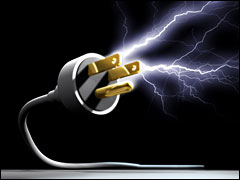Q. Hi Umbra,
Around the table at lunch today, my colleagues and I were discussing ways to conserve and be more energy efficient. We’ve all heard that “dormant” appliances still draw energy. We’ve all been told we should plug some of our electronics into a power strip that we can easily flip off when they are not in use. And, despite not really knowing the answer to my following questions, we all have done this in our respective homes. So if our TV, stereo, space heater, and cell phone chargers are plugged into a power strip, how much electricity is the power strip drawing (even if it has been flipped off)? Do we have to unplug the power strip too? Thanks for your wisdom and guidance on this matter!
Lily Lewison
Seattle, Wash.
A. Dearest Lily,
No, no, the power strip is there to save us from the arduous unplugging. In fact, I believe this labor-saving device is completely responsible for the hand-obesity epidemic amongst environmentalists and home conservationists. In fact, I have just learned of newfangled power strips that obviate even pressing an on-off switch. How will our fingers get adequate exercise with all these labor-saving devices?

Plug this puppy into a power strip.
Photo: iStockphoto
Let us provide background for those new to phantom loads. Home appliances and personal electronic devices pull electricity when in use, as we all would expect. Most also pull electricity when not in use, either while they wait poised on “standby,” or because they have a clock or LED light, or because their plug is poorly designed. (Only today did I learn the term “wall wart” as applied to the black transformer boxes appended to our phones, laptops, etc., which draw power simply when plugged into an outlet, even if not plugged into their affiliated gadget.) The amount of “phantom” power drawn in an average U.S. home is expensive per home and truly impressive nationally. According to the U.S. Department of Energy, around 75 percent of the energy used by our home appliances is drawn while we think they are “off.” Typical offenders include microwaves, stereo equipment, televisions, chargers for cell phones or iPods and co., and all the computer equipment.
Many of us solve this environmental and financial problem by plugging the offenders into a power strip with an on/off switch. When we are through using the appliances on a strip, we turn off the strip, which cuts the electricity to the appliances. Power strips control the electricity coming from the wall, and when they are off, the power is off to the attached equipment. Then, though the evil appliances wish to continue sucking power from the grid, they are thwarted. Trolling on the web will bring you persuasive testimonials from people who shrank their power use this way.
Now all kinds of equipment is available to tailor your phantom load reduction. From simply reading the descriptions, not actually trying the items, I think the most enticing fancy power strip is a Smart Strip. It has multiple outlets. One is the master outlet, so to speak, and when the appliance plugged in there is turned off by its user, all the connected outlets also shut off power. Two obvious ways to use this are in a home office, plugging the hard drive into the master outlet and the printer, scanner, fax, higgly-wiggly, into the connected outlets; and in a home entertainment center. A similar product is the Isole Power Strip, which does much the same thing but via a motion sensor — you leave the room, it turns off. I haven’t looked too far into this Isole strip, but logic dictates it uses some power itself to motion-sense, and it does occur to me that you might end up with the same problem one has with motion sensor bathroom lights. Sitting in the dark in the bathroom is easier than suddenly losing power in the middle of the World Series. Heaven forbid.
Other gizmos I must mention are various electric-use meters. One meter plugs into the outlet, the appliance plugs into it, the meter shows what the appliance draws. Two other meters measure energy use in the house as a whole and/or of the appliance to which they are nearest. These are good for motivation. The human often needs to see the effects of her actions before she changes her actions. But they are gizmos, and as such I hesitate to recommend them.
You can instead estimate your appliances’ energy use with these numbers from the Department of Energy. Or, just follow common sense and buy energy-saving appliances, turn off their power when feasible, and don’t buy too many unnecessary gizmos. And, yes, have faith in power strips.
Switchily,
Umbra

